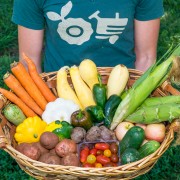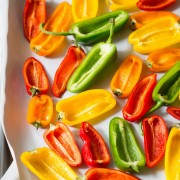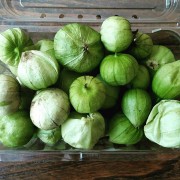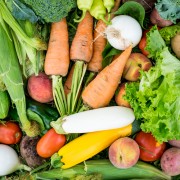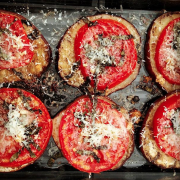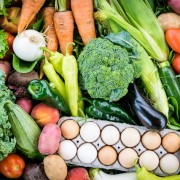A Healthy Twist on a Southern Tradition
When you think of traditional Southern food, what comes to mind? Sweet tea, collard greens, black-eyed peas, fried chicken, hushpuppies, okra, Smithfield ham, and sweet potato pie are at the top of my list. In fact, I just described what a traditional Sunday dinner used to look like at my great grandmother’s house. I can still remember sitting at a small table tucked into a side corner of her kitchen, watching her cook and taking in all of the wonderful smells that she was creating in the process.
While sweet tea, fried chicken, and hushpuppies haven’t made it to the Seasonal Roots market, I have come across several other traditional Southern favorites, including collard greens, black-eyed peas, and one of this week’s basket items, okra. I don’t remember eating the okra that was on my great grandmother’s dinner table, but I have had it throughout the years in soups or stews and maybe once or twice when eating out. It has been hanging out in my “take it or leave it” vegetable file. I would probably have never picked it up at the grocery store to bring home and cook, but I wouldn’t turn it away if it was offered to me, either. Fortunately for my taste buds, I was sent me home with a bag of Okra this week to experiment with in my own kitchen. Thank you, Erin!
I think that just about everyone thinks of fried okra when they think about traditional Southern foods, and with good reason. It is one of the easiest ways to prepare this vegetable and avoid the dreaded “slime” that is often associated with okra. I’m personally not a fan of fried foods, so I decided to find a healthier cooking alternative while experimenting this week. In the end, I tried out two methods: Oven-roasting and sautéing. Both turned out to be successful in our house and peaked my interest in cooking more with this interesting and versatile vegetable. Grilled okra is next up on my list. How do you prepare okra in your kitchen?
Easy Oven-Roasted Okra
It doesn’t get much easier than this, friends! For a delicious, slime-free side of okra, simply chop okra into 1/3” pieces and place onto a baking sheet. Drizzle with olive oil, season with salt and pepper, toss, and bake in the oven at 400 degrees for about 10-12 minutes, until slightly tender.
Indian-Inspired Okra
Ingredients:
1 pound sliced fresh okra ½ teaspoon ground coriander
1 medium onion, chopped ¼ teaspoon ground black pepper
2-3 tablespoons butter Salt to taste
½ teaspoon ground cumin ½ teaspoon ground ginger
Directions:
- Melt butter in a large skillet over medium heat. Add chopped onion and cook until tender.
- Add okra and remaining ingredients to the skillet and cook for a few minutes, stirring to combine ingredients. Reduce heat to medium-low, cover, and cook until tender (stirring occasionally). Enjoy!
Nutritional Benefits of Okra: There are a lot of healthy reasons to love okra. It is low in calories (just 30 calories per 100 grams) and full of dietary fiber, vitamins (A, B, E, C, and K), and minerals (iron, zinc, magnesium, potassium, and calcium).
Come join Seasonal Roots today!
Sarah Young is a wife, mother of three, Certified Health Education Specialist, and healthy living advocate. She has a background in Dietetics and a B.S. in Health, Fitness, and Recreational Resources with a concentration in Health Promotion. She is also a writer for several local and online publications, an ambassador for the Jamie Oliver Food Foundation, and a health contributor for ABC 7 News/WJLA. In her spare time, she enjoys running, hiking, gardening, and spending time with her family and their dog, Maple.



